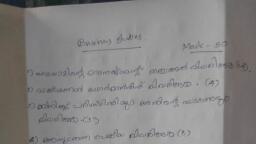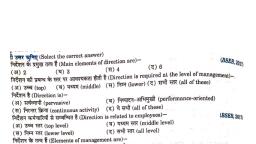Question 2 :
The appointments of intermediaries for a public issue is made by ___________________________.
Question 5 :
The principle that a subordinate should receive order and be responsible to only one boss is known as:
Question 7 :
Select the proper option from the probable option given below and rewrite the complete statements:<br>Henry Fayol is called as the father of _____ management.
Question 8 :
Select out the one that is not a part of the macro-environment________________.
Question 9 :
Which of the following is not one of the Porters five force factor?
Question 10 :
Three-step Model for successful change in organizations was introduced by __________.
Question 12 :
A vividly descriptive image of what a company wants to be known for _____________.
Question 14 :
Changes in which of the following areas did you identify as the main causes of strategic change?<br>(i) Environment<br>(ii) Business relationships<br>(iii) Technology<br>(iv) People<br><i>Select the correct answer from the options given below-</i><br>
Question 15 :
______ is a voluntary collective action to serve a common purpose. Whereas _______ is the orderly synchronization of group efforts so as to provide unity of action in the pursuit of common purpose.
Question 16 :
"Personnel Management is the recruitment, selection, development, utilization, compensation and motivation of human resources by the organization". This definition is given by.
Question 17 :
Which of the following function of management starts issuing orders and instructions to subordinates and ends with getting things done by satisfaction of various need of subordinates?
Question 18 :
As per TQM principles which of the following is problem _________.
Question 19 :
It is a process of transformation where the old system can no longer be maintained ____________.
Question 21 :
Which of the following is not a Principle of management given by Taylor?
Question 23 :
A scientist conducted a study on four different species of organisms(W, X, Y and Z) that are related in an aquatic food chain. He estimated the total number of individuals in the population of each species and the average biomass of each individual.<table class="wysiwyg-table"><tbody><tr><td>Species</td><td>Average biomass of each individual/arbitrary units</td><td>Number of individuals</td></tr><tr><td>W</td><td>$5000$</td><td>$85$</td></tr><tr><td>X</td><td>$14500$</td><td>$43$</td></tr><tr><td>Y</td><td>$32$</td><td>$200$</td></tr><tr><td>Z</td><td>$18$</td><td>$4000$</td></tr></tbody></table>Which of the following shows the correct relation of these species in a food chain?<br>
Question 26 :
When an organization assigns specialists to group people according to the projects they are working on is called _______.
Question 27 :
According to Peter Drucker, there are _______ phases in organising process
Question 31 :
State with reasons whether the following statement is True or False.<br>Planning has no vital importance in the process of management.<br>



























